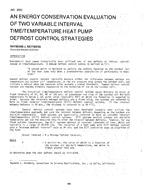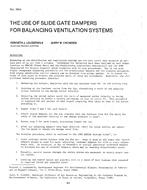-
-
Available Formats
- Options
- Availability
- Priced From ( in USD )
-
Available Formats
-
- Immediate download
-
$16.00Members pay $7.00
- Add to Cart
Customers Who Bought This Also Bought
-

CI-2663 -- An Energy Conservation Evaluation of Two Varia...
Priced From $16.00 -

CI-2654 -- The Use of Slide Gate Dampers for Balancing Ve...
Priced From $16.00 -

CI-2639 -- Latest European Developments in the Field of E...
Priced From $16.00 -

CI-2638 -- Two-Phase Flow in Sloped Gravity-Driven Conden...
Priced From $16.00
About This Item
Full Description
Two conflicting interests have been the cause of recent concern regarding the effects of heat upon people at work. One interest is the prevention of excessive thermal stress to occupants in indoor environments. The other is the reduction of energy consumption that can result by letting the indoor thermal environment drift toward a limit of acceptability.
In an attempt to address the problem of thermal stress, the National Institute for Occupational Safety and Health (NIOSH) developed criteria for recommended standards which would regulate occupational exposure to a hot environment. Work practices recommended by NIOSH require special procedures if the work environment exceeds 79 F (26.1°C) wet-bulb-globe temperature (WBGT) for males and 76 F (24.4°C) for females. However, even the proponents of these recommended practices admit that the exposure limit for women was only an estimate. Furthermore, the acceptability of wet-bulb-globe temperature as the sole thermal index for setting the thermal limits is also questionable.
To provide immediate energy savings in 1979, the Department of Energy implemented Emergency Building Energy Temperature Restrictions (EBTR). These restrictions specified that, during the cooling season, energy could not be used to control indoor dry-bulb temperature below 78 F (25.6°C) nor the dew-point temperature below 65 F (18.3°C).
As shown in Table l, the NIOSH recommendations and DOE requirements both exceeded the upper limits of the thermal comfort envelope specified in ASHRAE 55-74 at standard conditions. Thus, both documents would be expected to result in slightly-warm to warm thermal sensations which could be uncomfortable.
Solutions to potential conflicts that arise between energy savings and thermal stress require: (1) measures of the thermal environment; (2) measures of productivity or performance of the occupants; (3) indications of relationships between the two measures.
The overall objective of this pilot study was to observe worker productivity or performance under existing near-heat-stress conditions and to determine if relationships could be detected between environmental conditions and productivity. The specific objectives considered were as follows:
1. To search for basic relationships between measures of productivity in light. to moderate tasks (1-3 Met) and SET*.
2. To identify specific measures of productivity pertinent to the work (i.e., pieces per hour, total time per day on the job, total production, errors, delays, breakdowns, absenteeism, etc.) which were most affected by the thermal environment.
3. To evaluate the sensitivity of the effects of thermal variables on productivity,, independently, or in combination with subjective variables.





